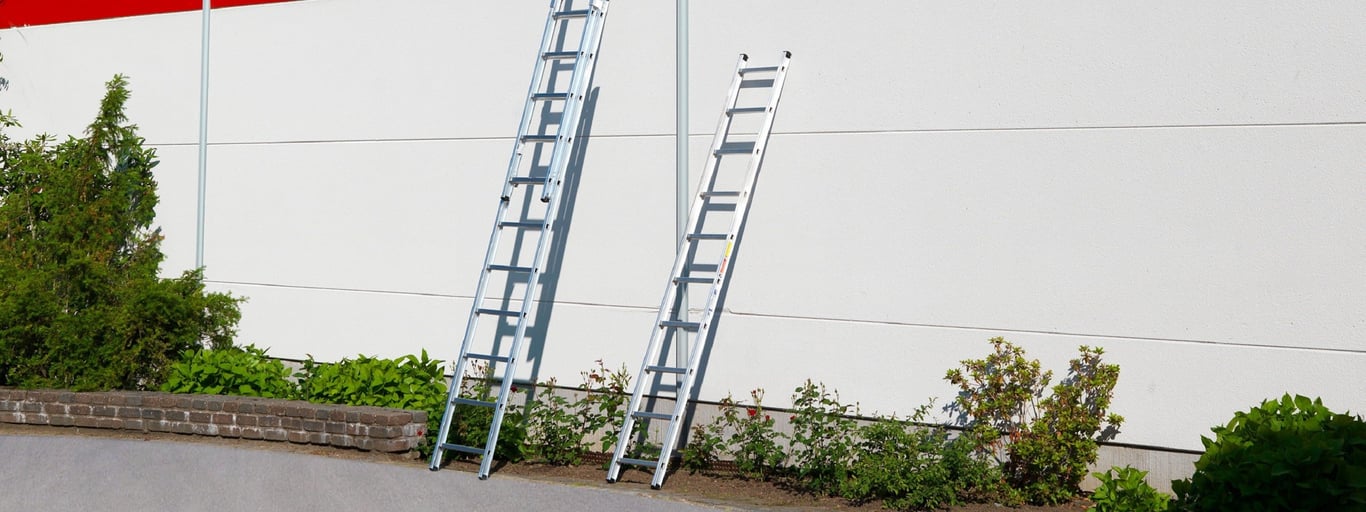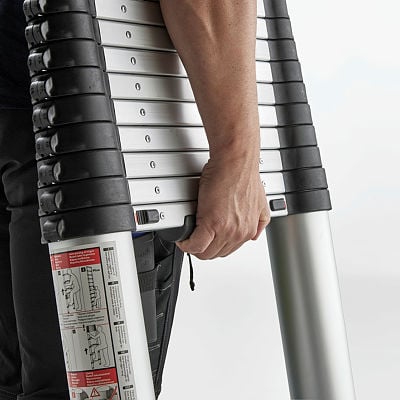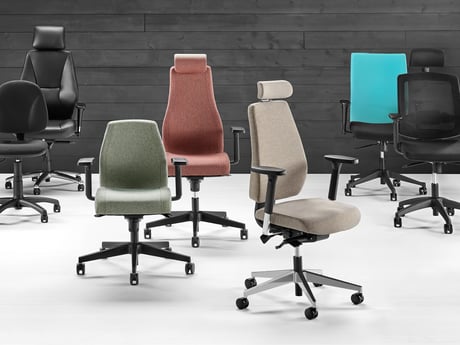- AJ Products UK
- Blog: Tips to Inspire Happiness at Work
- Buying guides
- The Ultimate UK Ladder Buying Guide: Safety, Certifications & Expert Tips

A Quick Guide to Ladders
In the UK, the market is flooded with a variety of ladders – from compact domestic models to robust industrial designs – and choosing one that meets both your needs and stringent safety standards can be challenging. This guide is designed to help you navigate the world of ladders, providing you with key insights into certifications, safety ratings, and practical buying tips.
Understanding Ladder Types

The ladder market offers a diverse range of designs, each tailored to different applications. The primary types include:
- Step Ladders: Ideal for domestic use, these self-supporting ladders are perfect for indoor tasks and short heights.
- Extension Ladders: Designed for reaching higher areas, these ladders are typically used in professional settings and can extend to impressive lengths.
- Multi-Purpose Ladders: Combining the features of both step and extension ladders, these versatile ladders offer adaptability for various tasks.
CLICK TO COMPARE LADDER TYPES
| Feature | Step Ladder | Extension Ladder | Multi-Purpose Ladder |
|---|---|---|---|
| Portability | High | Medium | Medium |
| Maximum Reach | Up to 3m | Over 3m | Versatile |
| Stability | Good | High (with stabilisers) | Variable |
| Best For | Domestic tasks, light work | Professional and high-reach tasks | Both domestic and professional use |
Certification and Regulations: What You Need to Know
Safety is the number one priority when choosing a ladder, and in the UK, this means ensuring that any ladder you purchase meets specific industrial standards. The most critical standard is EN 131, which applies across Europe and the UK. This standard is designed to ensure that ladders are fit for purpose and come with a safe working load rating.
Prior to the 2018 update, there were separate regulations for domestic, trade, and industrial ladders. However, the update streamlined these into two categories:
- Professional Ladders: Suitable for use on work sites and by tradespeople.
- Non-Professional Ladders: Intended for domestic or DIY use only.
All EN 131-certified ladders must have a maximum load rating of at least 150 kg. The certification not only ensures that the ladder can support the weight of the user and their equipment but also that it meets rigorous requirements for durability and slip resistance. Additionally, ladders that are 3 metres or longer must be equipped with stabilisers to enhance safety.
Other standards you may encounter include:
- EN 14183:2003: Applies to step stools, based on a maximum load of 150 kg.
- BS 2037:1994: Specific to metal and aluminium ladders.
- BS 1129:1990: Governs timber ladders.
In addition to these, the GS (Geprüfte Sicherheit) mark is a voluntary certification indicating that the ladder has been tested and complies with the German Equipment and Product Safety Act. Similarly, the SPCR 064 standard is used by the Swedish Work Environment Authority to ensure ladder safety.
Practical Tips for Buying the Right Ladder
Choosing the ideal ladder involves more than simply picking a model that looks sturdy. You should consider several factors that affect both the ladder’s performance and your safety:
- Purpose and Frequency of Use: Will you be using the ladder for occasional household tasks, or is it a daily requirement on a busy worksite? Professional use demands ladders that comply with higher standards and offer enhanced safety features.
- User and Environment: The ladder’s design should match who is using it and where it will be deployed. For instance, if you are working outdoors or on uneven surfaces, a ladder with robust stability features is essential.
- Maximum Load: Always check the safe working load of the ladder. This load includes the weight of the person plus any tools or equipment. Overloading a ladder can lead to catastrophic failure.
- Material: Ladders are available in various materials such as aluminium, timber, and glass-fibre. For electrical work, a non-conductive material like glass-fibre is recommended to prevent electrical hazards.
When you’re out shopping for a ladder, don’t hesitate to ask about the certifications it holds. A ladder bearing the EN 131 certification, for example, has undergone rigorous testing and is designed to offer reliable performance in its designated category.
Maintenance and Regular Inspection
Even the highest quality ladder can become a safety hazard if not properly maintained. Regular inspections are key to ensuring that your ladder remains safe to use. Before each use, check for:
- Loose or missing parts (such as rungs or stabilisers).
- Signs of corrosion or structural damage.
- Worn-out anti-slip features.
- Secure fittings and hinges.
Additionally, if you notice any damage, it is crucial to have the ladder repaired or replaced immediately. Over time, even minor issues can escalate into serious safety risks.
To extend the lifespan of your ladder, store it in a dry, secure place away from extreme weather conditions. This will help prevent degradation of materials and ensure that your ladder performs as expected every time.
Staying Safe While Working at Height
Like any tool, ladders must be used correctly to ensure safety. According to the Health and Safety Executive (HSE), the most common kind of fatal accident in 2024/25 continues to be falls from a height, accounting for over a quarter of fatal injuries to workers.
- Work from the ground where possible: Minimise the need to work at height by using extendable tools or performing tasks from ground level wherever suitable.
- Choose the Right Ladder: Always use the ladder that is best suited for the task. A ladder that is too short or unstable can lead to accidents. . For commercial and trade use, ladders should be certified to EN 131 Professional standard.
- Inspect Before Use: Ensure that your ladder is in good working condition before each use. A quick inspection can save you from potential hazards. You should check the feet, the rungs and the stiles for damage. On a stepladder, you should also check the platform and locking bars.
- Make sure the ladder cannot slip: This may mean tying the ladder to secure it or using a stabilising device. (Ladders over 3 m in height are required by EN 131 to have a stabiliser bar fitted.)
- Maintain Three Points of Contact: This can be two feet and one hand but may also be two feet and your body (knees or chest) if you need your hands to work. Always ensure you have a firm grip.
- Avoid Over-Reaching: Keep your body centred on the ladder. Stretching too far can cause a loss of balance.
- Adhere to the Maximum Safe Height: On leaning ladders, never work above the top three rungs and ensure the ladder extends at least 1 metre above your working area. For step ladders, avoid standing on the top three steps unless there is a designated handhold.
- Never Overload: Remember that the maximum load includes both your weight and any equipment you are carrying.
- Use the ladder alone: Never allow more than one person on the ladder at the same time unless it is specifically designed for multiple users.
- Electrical Work: If you are using a ladder for electrical tasks, ensure it is made from a non-conductive material, such as glass-fibre.
- Complete Safety Training: Ensure you have received adequate safety training from your employer before starting any work at height.
- Establish Emergency Procedures: Make sure there is a clear emergency plan in place in case of an accident while working at height.
Adopting these safety measures will significantly reduce the risk of falls or other accidents while working at height.
Additional Considerations When Selecting a Ladder
Beyond the primary features and safety regulations, consider a few additional factors before making your final decision:
- Ergonomic Features: Some ladders come with adjustable features that help reduce strain during prolonged use. Ergonomically designed ladders can help prevent back and joint pain.
- Portability: For those who require a ladder on the go, lightweight materials and compact designs are key. A ladder that is easy to transport can make a significant difference, especially for tradespeople who work in multiple locations.
- Cost vs. Longevity: While it might be tempting to opt for a cheaper option, investing in a ladder that meets high safety standards can save money in the long run by reducing the need for frequent replacements or repairs.
Ultimately, the right ladder is one that meets your specific needs without compromising safety. By understanding the various certifications and features, you can confidently choose a ladder that will serve you well, whether you’re tackling a weekend DIY project or working on a major construction site.
Conclusion
Ladders are indispensable tools that play a vital role in both domestic and professional settings. From understanding the different ladder types to navigating the maze of safety certifications such as EN 131 and BS standards, every detail matters when it comes to ensuring your safety.
We hope that this guide has provided you with valuable insights and practical tips to help you choose the right ladder. Remember: safety is paramount, and taking the time to inspect, maintain, and use your ladder properly can make all the difference.
Whether you are working from home or on a busy construction site, always invest in quality equipment and never compromise on safety standards. Happy and safe climbing!



